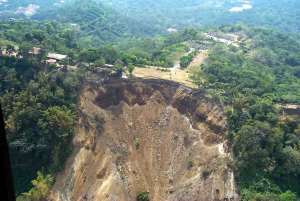
A Geological Engineer with the National Disaster Management Organisation (NADMO), Mr John Pinkrah, has cautioned that communities, drivers and people around the Akoasa Mountain, near the Weija Toll Both, are in danger of being swallowed to death by a developing landslide from the mountain.
He said the use of explosives and other crude methods to win sand and stones from the mountain, which sits two streets across the Densu River and on an earthquake prone area, coupled with the removal of the vegetative cover, had created dangerous and deep cracks allowing water to sip through the mountain during heavy rains.
Two weeks ago, after a heavy downpour, loose parts of the mountain fell and blocked the Kasoa-Weija portions of the road and this resulted in a traffic jam for hours.
Mr Pinkrah gave the caution during a familiarisation tour by the Hydro-Metrological Technical and Geological committees of NADMO, led by its National Co-ordinator, Mr Kofi Portuphy. The trip was meant to assess some disaster prone areas and assess the impact of disaster management mitigation works, instituted by the organisation, a month ago.
The works included the identification of disaster prone areas, ascertaining the number of people living in such areas who will be affected, identify safe areas to put them when their areas get flooded and interact with them on what to do when they saw water levels rising.
Mr Pinkrah said apart from water sipping through the mountain which was also closer to the Densu River, the Akoasa Mountain sat on the epic centre of earthquake prone areas, which include the area from Weija to Nyanyano and McCarthy Hills, described as higher risks earthquake prone areas.
Mr Portuphy expressed worry that the authorities in-charge were looking on idly, while the disaster threatened lives and properties.
He said the fact that the river lay directly opposite the mountain, was a clear indication that the water table was high. This means that large portions of the mountain could slip off any time after a heavy down pour and kill large numbers of people, not to conjecture what would happen to the numerous buildings on top of the mountain.
He expressed worry about the dangerous activities being undertaken by those who crack stones, some of whom worked with their children without any protective clothing, especially for their eyes.
Sensing danger, he said the assembly wrote to the Minerals Commission which withdrew the license of the quarry company but unfortunately other people had been using other methods to illegally mine stones from the area.
Mr Akwei-Thompson said the assembly had been educating the people destroying the vegetative cover and would soon be evicted by the use of force to prevent them from endangering the lives of people living around by their illegal activities.
Earlier, the team had visited the Weija Water Treatment Plant where the company was undertaking some controlled spillage because the dam was getting full.
But for earlier disaster control measures instituted by NADMO, such as disilting of gutters and drains, creation of dykes, places such as Bortiano, Tsokome, Lower Weija, Sapema, Lower McCathey, Lower Oblogo, Pambrose would have been flooded.
Tettegu, which used to flood every year, was dry this time around.
A resident, Mr Jonny Johnson, commended NADMO for the support but appealed to the municipal assembly to ensure that the dykes were turned into concrete drainage so that they would not be washed away with time by strong tides.
By Donald Ato Dapatem, AKOASA
Graphic.com.gh/Ghana




 Western North been sidelined for far too long; address our needs before 2024 ele...
Western North been sidelined for far too long; address our needs before 2024 ele...
 Effutu: 'Stop eating at night and take care of your health' — Afenyo Markin advi...
Effutu: 'Stop eating at night and take care of your health' — Afenyo Markin advi...
 Akufo-Addo's desperate attempt to disrupt Yagbonwura's 1st year anniversary cele...
Akufo-Addo's desperate attempt to disrupt Yagbonwura's 1st year anniversary cele...
 Armed robbers attack, rob Sethi Brothers Ghana Limited in Tema
Armed robbers attack, rob Sethi Brothers Ghana Limited in Tema
 SML deal: We commend Manasseh for holding gov't to account, Akufo-Addo for not s...
SML deal: We commend Manasseh for holding gov't to account, Akufo-Addo for not s...
 Our recall invocation is in good faith to consider three key issues – Majority
Our recall invocation is in good faith to consider three key issues – Majority
 You’re inviting bad luck upon yourself if you use Indian hair — Spiritualist war...
You’re inviting bad luck upon yourself if you use Indian hair — Spiritualist war...
 Ejisu by-election: Police questions Kwadaso MP, two others over bribery allegati...
Ejisu by-election: Police questions Kwadaso MP, two others over bribery allegati...
 Nana Kwame Bediako is Nkrumah’s reincarnate; he’ll be president if he appoints N...
Nana Kwame Bediako is Nkrumah’s reincarnate; he’ll be president if he appoints N...
 Dumsor: Mahama gave us ‘dum, dum, dum’ but we are now in the era of ‘dum sie sie...
Dumsor: Mahama gave us ‘dum, dum, dum’ but we are now in the era of ‘dum sie sie...
